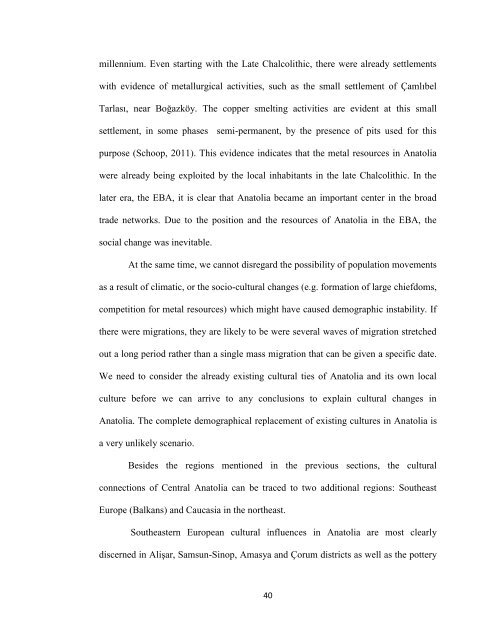EARLY BRONZE AGE DAGGERS IN CENTRAL ... - Bilkent University
EARLY BRONZE AGE DAGGERS IN CENTRAL ... - Bilkent University
EARLY BRONZE AGE DAGGERS IN CENTRAL ... - Bilkent University
You also want an ePaper? Increase the reach of your titles
YUMPU automatically turns print PDFs into web optimized ePapers that Google loves.
millennium. Even starting with the Late Chalcolithic, there were already settlements<br />
with evidence of metallurgical activities, such as the small settlement of Çamlıbel<br />
Tarlası, near Boğazköy. The copper smelting activities are evident at this small<br />
settlement, in some phases semi-permanent, by the presence of pits used for this<br />
purpose (Schoop, 2011). This evidence indicates that the metal resources in Anatolia<br />
were already being exploited by the local inhabitants in the late Chalcolithic. In the<br />
later era, the EBA, it is clear that Anatolia became an important center in the broad<br />
trade networks. Due to the position and the resources of Anatolia in the EBA, the<br />
social change was inevitable.<br />
At the same time, we cannot disregard the possibility of population movements<br />
as a result of climatic, or the socio-cultural changes (e.g. formation of large chiefdoms,<br />
competition for metal resources) which might have caused demographic instability. If<br />
there were migrations, they are likely to be were several waves of migration stretched<br />
out a long period rather than a single mass migration that can be given a specific date.<br />
We need to consider the already existing cultural ties of Anatolia and its own local<br />
culture before we can arrive to any conclusions to explain cultural changes in<br />
Anatolia. The complete demographical replacement of existing cultures in Anatolia is<br />
a very unlikely scenario.<br />
Besides the regions mentioned in the previous sections, the cultural<br />
connections of Central Anatolia can be traced to two additional regions: Southeast<br />
Europe (Balkans) and Caucasia in the northeast.<br />
Southeastern European cultural influences in Anatolia are most clearly<br />
discerned in Alişar, Samsun-Sinop, Amasya and Çorum districts as well as the pottery<br />
40
















